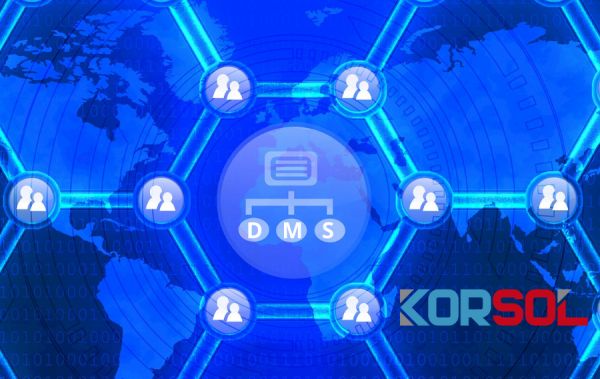What does DMS mean?
DMS acronym consists of three words: Document Management System. Obviously, it is associated with tackling the company’s documentation. The definition is very superficial and many different processes may be matched to it. It regards i.a. accounting documentation, HR, agreements, commissions, corporate correspondence, applications, decisions… Each enterprise has different needs in terms of document flow and documentation processes to be managed. Hence, DMS is not the same in particular companies and does not give the same options.
What is DMS for?
It might seem obvious, that companies deal with document flow and management. However, the more employees, cases, processes and departments, the more difficult the task of keeping them in order becomes. And the document may be of great worth, because correct and fast case processing guarantees customers’ happiness, less legal difficulties and financial security. Many companies claim, that they are able to manage paper documentation properly and it is enough for them. It is of course possible that well-organized departments are able to transfer papers effectively, within the right order of decision-makers, however they will never outperform IT systems in terms of precision, speed and automation. Even in the companies which have implemented a total documenting regime, the circulation of e.g. an invoice may take over a week. Not mentioning some complicated decision-making processes, where a whole chain of people must, in a correct order, add notes, accept items and sign the document. There is hardly any place for new procedures which require different path of document circulation, since it usually causes disorganisation. In companies consisting of multiple departments and dealing with tons of paperwork, it is very easy to lose those valuable writings or keeping them for too long on an overloaded desk. And every day of delay might trigger some not very pleasant consequences, including those financial ones.
To solve the abovementioned problems, a high-quality DMS should offer:
- Safe data storage in cloud or as an on-premise server version, compliant with all the prevailing GDPR provisions.
- Records and the ability to check the history of each document: changes, approving employees, date and time of performed actions.
- Converting and editing documents in a suitable format, including data export to Excel sheets.
- The opportunity to share documentation, adding notes and comments simultaneously by different users, which considerably shortens the time of invoice costs description.
- OCR elements automatically reading and filtering data from scans and pdf documents.
- Creating new, authorial paths of document circulation, building workflow procedures together with determining the employees responsible.
- Setting notifications and alerts so as to reassure fast document flow between departments in the right order and before deadline.
- Easy filtering and searching corporate documents either through case number, title, client or category.
DMS – benefits and abilities
Document Management System is a tool which many companies can offer, but it usually comes in very basic, elementary version. Software producers for business often think it is enough to enable the users to save, read, filter, comment and load attachments. Sometimes some elements of OCR (Optical Character Recognition) are available. However, there is usually no automatization of document flow. solutions differ from other products through customizing clients’ workflow procedures, different for each process. Within the procedure the document is assigned to a fixed path right after registration and gains a group of users responsible for processing it. Other IT producers’ “workflow” usually means typing the recipient which must perform next stage tasks. The sender must decide on their own who is going to work on the document next, search through the whole list of employees for the email address or remember it. All this does not differ much from a simple email account. Why pay so much then for something that only has a catchy marketing name?
What is more, the next worker which is the addressee of the message/procedure receives it only to their private mailbox. Dozens of such messages might come a day, so it is very possible that the decision/document transfer/filling will not be performed on time. It delays the procedures considerably and finishing tasks takes way too much time. And here all the DMS opponents are right claiming that it would be much faster to simply walk through the company with necessary documents. That is accurate but only when it comes to the basic versions of DMS.
KORSOL, as it has been mentioned before, does not only restrain itself to creating basic features. Each toll is tailored to individual client’s needs only after getting to know properly all the processes. Next, the subsequent stages of the procedure are developed and the client draws a list of users licensed to use the tool together with their inscribed roles and decisions they must be responsible for.
What makes strategy so innovative?
DMS tools created by are not a fixed, closed product, but rather a complex group of solutions for different company departments. Document Management System may be performed through workflow processes which are suitable for different company performance scopes. DMS sometimes means invoice circulation, sometimes correspondence management, issuing task orders, agreements and decisions. Each type of document remains a separate business process with its own aim, procedure, decision-makers, deadline etc. That is why for every document an analysis should be performed separately with different outlines of procedures. Most software designers do not do that, forcing clients to buy “universal” solutions.
on the other hand, puts emphasis on customization through BPMN, that is Business Process Model and Notation for better management. Through that, the discussions about the new implementation are easier and more efficient. BPMN proves useful also during further talks with employees on the subsequent changes and ideas that need to be taken into account in the project. Meetings, consultations and information exchange with client’s employees are to develop the whole concept gradually and, not only in theory, should be as frequent as possible. We are aware that not everything is possible to be predicted in terms of document procedure paths, potential difficulties and necessary modifications. Several talks over the work aspects of the departments allow us to understand client’s needs more thoroughly and avoid misconceptions. It is also very important to carry out the consultations using some graphic representation of the processes. BPMN remains therefore an extremely useful tool while talking to clients: not only does it help the receivers build a very detailed scheme of information flow but also lets the contractor keep the work in order.
What does DMS procedure look like?
Let us see what happens throughout the document management process. In the beginning the document must enter the system. The workers initiate a new case in the system and enclose an attachment (e.g. an invoice scan, correspondence docx file etc.). Then, after filling all the necessary boxes (number and character of the boxes is chosen by the client) one must click “Save” which in turn starts the procedure and displays status “Document created”. Only then the case is given a special workflow panel with visible buttons of procedure path choice. The user who uploads the document must click one of them and the case proceeds automatically to another decisive party. If no path is chosen, then the case remains in the system with “Created” label, so the supervisor can verify easily who is responsible for the case’s delay. The rest of the procedure is constructed in relation to the client’s preferences, but always guaranteeing automatization, statuses and workflow decision panels. It is also worth mentioning that there are limited permissions in terms of filling/correcting the case data and after confirmation and sending further there is no possibility to edit them.
As mentioned before, most of software producers aim at mass distribution of their products, deliberately limiting the automatization tools. As a consequence, the facilitations are visible only in OCR invoice tools and in determining the next receiver of the documentation processed. The advantages are not so impressive then and they do not really save time. puts emphasis on the most menial tasks connected with documentation to shorten them considerably. Through our workflow mechanisms the user has less clicking and does not have to always determine the receiver: the case is automatically forwarded to the right department/post depending on the type of the document. If human decision is inevitable, only some users are given permission to perform such actions. Due to an unique, elaborate notification system (it is possible to set notifications within the sole system, in emails and text messages) the company avoids disinformation.
Order means profit
What makes DMS so unique? Absolute control of the supervisor over the tasks performed inside the system. Due to the records of subsequent action together with the time and user’s name the management may constantly monitor the manner of documentation handling, easily detect errors and malpractices. All this brings complete transparency and punctuality.
Document Management System implementation means also maintaining order and multitasking. Developing businesses must process new clients all the time and the growing numbers disturb right organization. But when cases inside the system are sorted properly, divided into departments, deciding parties and stage, the pace of processing actions rises. In addition, the ability to filter and generate reports makes way to analyse new solutions. All that brings higher profits and further business development.
.






